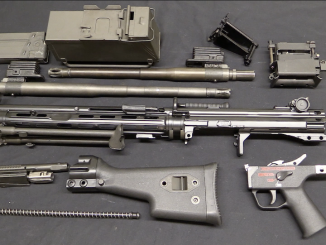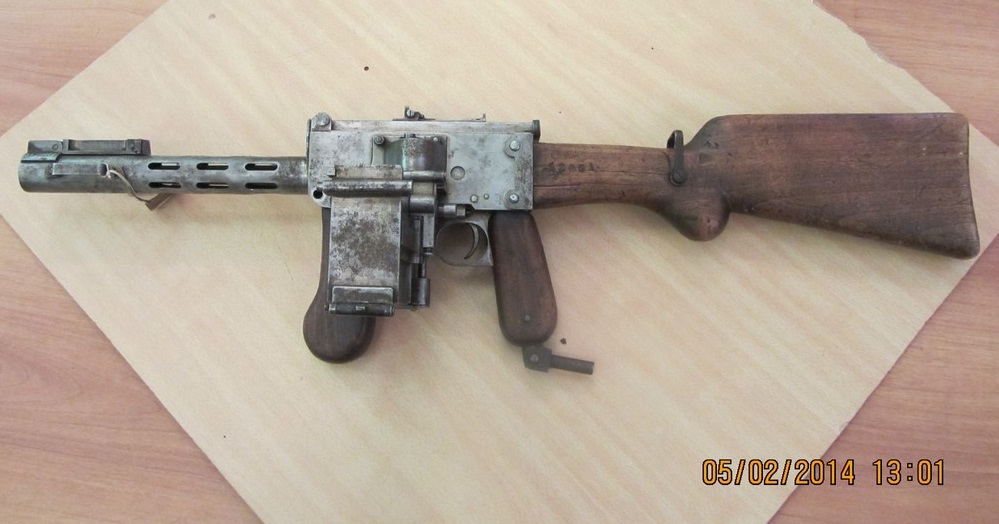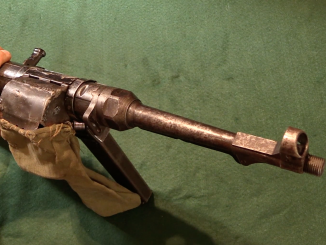https://youtu.be/XouWRwFPMvU
This rifle is being sold by Morphys on October 30, 2018.
The FG-42 is a tremendously hyped rifle, but very few people have ever had a chance to actually shoot an original one (including me, until today). It was a rifle intended to take on the roles of both infantry rifle and light machine gun gun for the German Fallschirmjager. The M14 was supposed to do the same thing, and was neigh uncontrollable. So the question is, was the FG-42 a better design, or did its reputation simply come from the mystique of a very rare gun?
Well, in my opinion the praise is entirely justified. This was one of the most controllable and pleasant-shooting full power select-fire rifles I have ever shot. It is absolutely far better than the M14, and better than the AR-10 as well and also the G3 in its stock form. The FAL is a closer competitor, but in my opinion still outclassed by the Fallshirmjagergewehr. The FG was expensive and not as durable as its later competitors, but it truly is a very impressive piece of engineering. This particular one is going up for sale at the Morphy auction company (which acquired the James D Julia firearms auction a few months ago), and I hope the new owner enjoys it as much as I did!
If an original FG like this one is out of your price range, consider the semiauto reproduction made by SMG Guns in Texas. Their web site is awful, but their guns are excellent!




I hope a tabletop review of the inner workings of this gun is coming.
He did one several years ago:
https://www.forgottenweapons.com/fallschirmjagergewehr-fg-42-video/
He also had another video, but no field stripping:
https://www.forgottenweapons.com/transferable-fg-42-at-ria/
The Brits worked on a bullpup version, https://www.forgottenweapons.com/the-korsac-em1-a-britishpolish-bullpup-fg-42/ A different take on it, but operating very similar.
Some years ago I have seen videos produced by German FG42 retro-producing company but cannot locate it now (I believe they went out of business). As replacement this video will probably help https://www.youtube.com/watch?v=i4uhEoIOzkg
How FG-42 works (working cut-away 3D model): https://www.youtube.com/watch?v=SMTIZuBtVyw
I can’t stop grinning!
I have one of the smg semi automatics. Although the left side magazine causes some ergonomic issues and I feel the overall length makes handling in brush or an urban environment difficult, I was amazed at how accurate I was shooting freehand. Yes heavy in my arms, but pretty much a tack driver at 50 yards with iron sights. It was picky about ammunition and given the cost I only dared to use modern noncorrossive ammunition. I did notice the bolt sticking when dirty. Not sure if this was due to less than 100 rounds through it. The bayonet on the smg reproductions is a filed down MAS 36 spike bayonet. I really would like to know how accurate it is on full auto. To me it sits on the evolutionary tree between the mg42 and the stg. Any idea of what the relative cost back in ww2 of the mg42 versus the fg42? I’ve fired the m60 and except for the barrel change and beltfeed, I consider the fg lighter and more accurate. I realize one reason why so few were made was a lack of strategic materials. Most that were produced ended up in the east.
Completely agree with Ian’s enthusiasm. This is so far unsurpassed long small arm in existence. It has all right ingredients: in-line spring loaded stock, high above bore sights and excellent muzzle device. It is relatively light and short. Tell me if you can fire M14 in full auto and hold it on target in same way!
I have been recently present at shooting of 8mm Mauser from vintage hunting rifle; an impressive experience – this shot means business. Now, for fun sake: US army has re-vitalised plan for new generation of support weapon and rifle. The projectile is pre-set to be at 125gr/3,500 fps at muzzle. I’d say, update this gun in 7mm Mauser and you’ve got what you want.
Caliber of mentioned “prospective projectile” is 6.8mm. It is obviously intended for use in excess of 500m, therefore low drag type; not 6.8mm SPC. It is likely it will require higher chamber pressure, but FG42-X could be modified accordingly.
“FG42-X”
What is FG42-X?
“This is so far unsurpassed long small arm in existence.”
Well, I would say that it was achievement to made weapon which has to full-fill apparently mutually exclusive requirement being kind of sub-machine-gun+rifle+light-machine-gun combination in quite light package, it has also its flaws, as mentioned it was expensive to made, but also notice that its chamber is actually intentionally bigger than Gewehr (volume 106,63% of Gewehr 41 chamber volume) which resulted in lower pressure (13,3% less average pressure) thus making extraction easier, but as side effect muzzle velocity was lowered (1,5%) and while it worked as intended with brass-cased cartridge, reliability was low when steel-cased cartridge were used.
https://mgewehr.wordpress.com/2018/08/25/fg-42/
“was the FG-42 a better design, or did its reputation simply come from the mystique of a very rare gun”
I always though it has this reputation because it was used (or to more precise – wielded, as no shots were fired) by German paratroopers during Unternehmen Eiche
The FG42-X is a hypothetical design based on aforementioned new U.S. army requirement. There is no such weapon in existence.
I wonder how you came across data on “enlarged chamber”. You cannot go beyond elasticity of cartridge or you end up with stuck case (fail to extract). Length-wise, maybe but not in diameter.
I acknowledge FG42 as success in sense that it full-filed requirements which were not easy, yet I am reluctant to declare FG 42 (or any selective-fire fire-arm) as “unsurpassed”, as to vague, as there is not one method of measuring “bestness” for mentioned selective-fire fire-arm, so you can measure like length or Rate-of-Fire.
Finally, as old economic adage goes There ain’t no such thing as a free lunch
Having praised FG42 does not mean I do not have respect for other designs of the period such as M1 Garand or SVT-40.
“excellent muzzle device”, sure for muzzle rise and recoil control but not as a flash hider! Could be the ammo but what a heck of muzzle flash. No good for night ops, you could stay on target but you won’t see it anyway.
oh my GOD i am so insanely jealous!!!!!
Went right to Larry Vicker’s video after this. Larry always deserves a shout out. I love that you collaborate with people when possible. The only other person I know so amiable is my best friend. I so wish I could up my Patreon donation to a consistent $50/month. I know there are guys who do a supreme job of written articles but for this medium you are top notch.
Oh and the FG-42 is the original Kraut Space Magic 🙂
“Kraut Space Magic ”
What that does mean? It is derogatory term?
No, its a term started with computer games for the HK G11 which went from a real world prototype into this god like must have firearm. It’s an odd sort of reverence to German engineering feats. I’d personally have called it “Deutsche Space Magic” but I didn’t come up with the meme.
Ian
Welcome to the club! I too have spent a bit of time with original FG42s, including putting a bit of lead down range.
I basically agree with you. It is an incredibly impressive weapon. Though not perfect.
The colossal (at night, or in overcast conditions) blast/flash is a real issue. I suspect it applies also to the very first AR10s. If you specify this with a more conventional grenade-launching and bayonet-compatible flash hider, how much control is lost?
Cocking handle is on wrong side. Selector is difficult to move quickly.
These were built quite close to minimum acceptable safety/durability levels. I know of one early one that has not apparently had a hard life (though may have been test-fired a lot by the British Army in the 40s) that is now judged unsafe to fire because of incipient cracks in the bolt lugs.
The genesis of the thing was Crete, when, for weight and size reasons, parachutists dropped separately from the canisters holding their rifles and light-role GPMGs. Problem, they often got separated, or could not find the canisters, meaning a section armed only with pistols and one SMG fought British infantry armed with rifles and a Bren.
So the 42 replaced the Kar98K and the MG34.
But it did not, I believe, fill the LMG role.
I have not traced any documentation on how the Fallschirmjager intended to use the 42. But they were clear that the FG42 was a semi-auto weapon with auto reserved for emergencies.
Nothing in what I have seen suggested they intended a section to replicate the traditional separate rifle group and MG group of conventional infantry.
The documentation instead stresses semi-auto use. Not what you would expect in something intended for use as an LMG.
And why would you have, say, five guys firing the 42 on single, coordinating with a separate group containing the section leader (non-firing), a gunner (firing the 42 as an LMG) and an asst gunner (non-firing) doing mag changes, in preference to either one group all behaving the same or two equal groups, all firing (on semi except for the final assault, break contact drills etc)?
The irony is that this thing was specifically designed to meet the needs of paratroops because of Crete. But, after Crete, paratroops almost always were used as ground infantry.
The other irony, as you imply above, is that the FG42 showed that if you want a full-power rifle that is effective on hand-held full-auto, you need a compensator and a straight-line (high sight level) stock. And it will probably weigh 9-10lbs. Whereas dear old Col Studler and his minions were sure you could achieve that with a conventional stock, no muzzle brake, and weighing 7lbs. That delusion would be understandable, except that the 42 showed exactly what was and was not possible, with what consequences.
Some observations.
“I have not traced any documentation on how the Fallschirmjager intended to use the 42. But they were clear that the FG42 was a semi-auto weapon with auto reserved for emergencies. ”
This would make sense, considered that paratroopers due to nature of their operations are always short on supply, so saving ammunition make sense.
One clarification. When I said the 42 “replaced” the Kar98K and MG, I meant that was the idea. In reality, the 42 did not enter anything resembling significant production until the second half of 1944, by which time the Germans were desperate for weapons. The pictures I have seen of the FG42 in actual use suggest that they were issued piecemeal, into units still using the Mauser and the MG34 or 42., and MP40. I have seen no evidence that any unit of any size was fully rearmed with the 42. The photos of the raid to free Mussolini show a mix of weapons, including a few early FG42s, but also many Mausers.
The Luftwaffe rejected the Mkb42/MP43/MP44/StG44 as not full power. With hindsight, that system would have been an equally effective, cheaper, and earlier available option (except for the limitations on making 7.92×33 ammo, that dogged the Sturmgewehr programme).
Final thought. Why am i so interested in the FG42? Because, historically, it is arguably the most ambitious and chalke ging specification for a weapon that has actually led to a weapon being successfully fielded in actual combat. Unlike SPIW, ACR, etc.
Anyone in the weapon design business needs to study the FG42.
“Anyone in the weapon design business needs to study the FG42.”
Here I want note it was created by Louis Stange and it wasn’t his first weapon with parts of mechanism inside stock, earlier example is Rheinmetall sub-machine gun, see 4th image from top here: https://www.kalashnikov.ru/prodolzhit-razrabotku/
it can be clearly seen that spring is inside stock and additionally it is “bent” layout (like MAS 38), this sub-machine gun was created around end of Great War and was later developed into Steyr-Solothurn S1-100, Stange also created MG 30 (Austrian designation) alias 31M (Hungarian designation), see 1st image from top here:
http://zonwar.ru/pulemet/Steyr-Solothurn_mg-30.html
which also has mechanism in stock and additionally was also in-line layout – features which would also appear in FG42, however MG 30 was short-recoil, had quick change barrel and weighted 9,5 kg (heavy in comparison to FG42, but quite light in comparison to then-used light machine guns)
*challlenging*
Bloody auto-correct.
Night, night, chaps (not as auto-correct suggested, “chaos”). 🙂
Well, all things considered, the FG-42 is a battle rifle meant to keep its distance from the other team. I’m pretty sure the Luftwaffe didn’t put it through an endurance test (when I say endurance, I mean ABUSE TO THE POINT OF SMASHING IT INTO ROCKS AND TREES FOR SEVERAL HOURS ON END).
“ABUSE TO THE POINT OF SMASHING IT INTO ROCKS AND TREES FOR SEVERAL HOURS ON END”
Do you want to add yet another requirement which would be again mutually exclusive with actually enacted? It is success that it full-filled already ambitious requirements.
I must admit I have difficulty with accepting this kind of “endurance” measure. You have to make your choice: ether to take care of your weapon and use it with that mind set or purposely abuse it. This topic is heard so often I wonder of reason/ purpose behind it (I know children have often fun when their toy cars ‘crush’ and an ad was made to apply it for name of drink).
I san tell you from my own (peacetime although under threat of major conflict day to day) experience, we were directed to take care of our weapons and if case of intentional abuse or neglect arose, it would be addressed by military court with severe implication to perpetrator.
Ian,how’s FG42’s full auto controllability compare to other automatic rifles, like for example,BAR?
Would you consider FG42’s full auto fire militarily usable?
Another question not only for Ian, is there a scientific/objective method to determine the full auto controllability of a rifle?By grouping?Or it’s just subjective?
I doubt Ian will answer you here, since this now an old post. So, for what its worth, my impression is that he considers it about as controllable in full auto as the Colt Monitor. The Monitor, while light for a BAR variant, is a much heavier weapon and has an even bigger compensator. Ian’s video on the Monitor:
https://youtu.be/Jb6C9ASylmQ
There is no way to really objctively assess the controllability of a full auto weapon, since it depends on so many subjective factors: shooter’s weight, strength, size (hands & limbs) and technique. The most scientific thing one could do would be to choose a group of people representative of the prospective users and ask their opinions in a questionnaire.
Lowering the rate of fire from 750 rounds per minute to 450-500 would be a significant upgrade in controllability.
Maybe making the receiver longer by 10 cm would decrease it, omitting the buffer and have bolt carrier slow down by spring, not hitting anything in the end of travel.
I have considered that before.
In order to make FG42 suitable for massive deployment,unit cost must be lower.
So the receiver needs to be simplified for production, buffer needs to go.
To maintain the controllability, by lengthening the receiver, while lowering the firing rate, constant recoil principle would also make recoil profile much more friendly.
I would shorten the barrel by at least 5-10 cm, to stay in the overall dimensions.
Anybody knows, this 20 inch barrel is with muzzle brake attached, or without it ?
Firing from open bolt makes it more controllable in full auto, so thats a very good design feature, maybe that was the main intention, not to prevent “cookoffs”.
Other rifles he mentioned, do not fire from open bolt, if they could, they would be better in f.auto mode.
Also, it would be cool to see if they,germans, ever experimented with 7.92×33 conversion, so far I’ve never heard of it, but its hard to believe nobody never even only thought about it.
The Swiss Sturmgewehr 52 was chambered for the Swiss intermediate 7.5mm “Kurzpatrone” (7.5×38mm) and it was a derivative of the FG 42, although not a copy by any means.